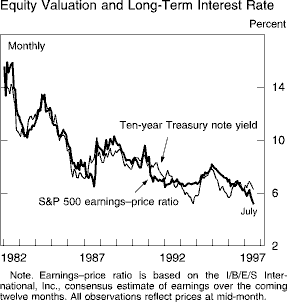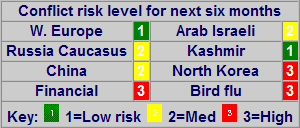The "Super-Nomads" and the fifth era
Strauss and Howe characterized generational cycles as having four
20-year eras, totalling roughly 80 years - 20 years for the crisis
era and 60 years for the three inter-crisis eras. They don't
consider the possibility of a fifth era, even though three of six
Anglo-American crisis periods they talk about are over 100 years
long. In my own analysis of over 100 inter-crisis periods throughout
time and history, the average inter-crisis period was about 60 years,
but 15% of them were over 80 years long, indicating that there's an
additional era, a fifth era, in about 1 out of 6 crisis cycles.
We've had lengthy discussions of long mid-crisis periods in this
thread in the past, but the discussion has always been theoretical.
However, recent news events -- the Iraq war and the London Sunday
bombings -- have made them highly relevant to what's going on in the
world today.
On my web site, I've pointed out several times that the Iraqi
insurgency, especially the suicide bombings, is comprised mostly of
Saudis and Jordanians, not Iraqis. I attributed this to the fact
that Saudi Arabia and Jordan are in crisis periods, while Iraq is
just beginning an awakening period.
Robert Pape's Dying to Win
When Robert Pape's book,
Dying to Win : The Strategic Logic of
Suicide Terrorism came out, I commented on it extensively,
http://www.generationaldynamics.com/...0.i.050718pape
showing that London suicide bombers were in the Hero generation
following the India-Pakistan crisis war, and the partitioning of the
Indian subcontinent into Muslim and Hindu portions, but leaving the
Kashmir region in dispute. I showed that Pape's analysis makes a lot
of sense in light of the concept of crisis wars.
However, there's a lot more. Pape presents an analysis of the
nationality of al-Qaeda suicide attackers, and finds that they come
from several different countries, but that they overwhelmingly come
from just two countries: Saudi Arabia and Morocco.
Now, as it turns out, these two countries have had above-average
mid-cycle times since their last crisis wars. Saudi Arabia's last
crisis war was the Ibn Saud conquest, ending in 1925, and Morocco's
was the Rif War, ending in 1927. This is the kind of result that you
would expect from Generational Dynamics, and it provides a fairly
dramatic confirmation of parts of Generational Dynamics. That's why
Pape's work has been very exciting to me.
The suicide bombers from Saudi Arabia and Morocco came of age in the
"fifth era" following a crisis war. If a crisis war had occurred on
schedule during the fourth era, then these suicide bombers'
generation would be Artists; and Artists get to be that way because
they suffer a kind of "generational child abuse" from growing up
during a crisis war. Since there was no crisis war, there was no
generational child abuse, and the characteristics that S&H assigned
to Artists aren't going to be there any more.
What happens in the Fifth Era?
So what happens to Heroes and Artists when there's no crisis war?
I can only speculate. Maybe the would-be Heroes become frustrated
because they don't fulfill their destiny of becoming heroes. Maybe
the would-be Artists inherit the heroes' frustration, and become even
more disaffected than Nomads do.
Because of their increased tendency to become suicide bombers, I call
them "
Super-Nomads."
The willingness to die for one's country in a genocidal crisis war is
well established: you only have to look at the tens of thousands of
young Americans willing to get shot down like fish in a barrel on the
beaches of Normandy in 1944.
Civil War
But suicide bombers go several steps further in their willingness to
be genocidal: They're willing to kill civilians, they're willing to
commit suicide altruistically, in a way that's not officially
approved by their governments.
Here's another issue: What would cause someone to pick up a machete,
go next door, kill your neighbor and dismember his body, kill his
children, rape his wife, and then kill her and dismember her body?
And what would cause large masses of people to do the same thing?
That's what happened in the Balkans and Rwanda in the 1990s. The
hypothesis is that civil wars are more likely to occur during "fifth
eras," as the frustration builds up among the thrwarted heroes for
not having a war. Three examples:
(*) United States, 1861-65: The previous crisis war was the
Revolutionary War, ending in 1782, 79 years earlier.
(*) Rwanda 1994: Rwanda's last crisis war was the Belgian Congo
invasion of German-held Rwanda, 1916-1918, ending 76 years earlier.
(*) Balkans, 1991-95: Previous crisis war was WW I, ending in 1918,
73 years earlier.
Of course other civil wars occur in the fourth era, as scheduled, so
this is nothing more than a hypothesis.
But this observation also has relevance to today's events, since
Mexico is also in a "fifth era": Its last crisis war was the Mexican
Revolution, ending in the early 1920s. Today, we see law and
order breaking down completely in Mexico, with drug lords taking
control in the north and Zapatista paramilitaries becoming
increasingly violent in the south. Mexico is due for a new civil
war, and it will certainly spill over into California and the rest of
southwestern America.
Nomads versus Super-Nomads
If these speculations are true, then they show a very important
commonality between the Nomads and the Super-Nomads.
In a normal crisis period, the Prophets provide the vision, but each
Prophet has his own individual vision. It's actually the Nomads who
make the choices, since they decide which Prophets' visions to
implement. Thus, the Nomads decide what's going to happen during the
crisis.
In a fifth era crisis war, the unfolding of events seems to be quite
different. The Nomads are now too old to provide more than a vision,
but the would-be Hero generation can't select from among the Nomads
"visions," since the frustrated Heroes are programmed to do what the
Nomads decide to do, rather than making the decisions themselves, and
the Nomads aren't the "vision generation" anyway..
So the Super-Nomads take things into their own hands -- by suicide
bombings, terrorism, and a rebellion that "spirals out of control"
into a civil war. This would explain, for example, what's happening
in Mexico today, and may even provide insight into what's happening
in Saudi Arabia.
One more point. Ever since I did the analysis that revealed that no
crisis war ever occurs less than 41 years after the end of the
previous one, I've found that to be a continuing source of wonder and
amazement. I've mentioned it frequently on my web site with respect
to the impossibility of a civil war in Iraq, despite the fact that
that pundits and politicians talk about civil war in Iraq in
practically every other sentence. But how could it be possible for
nations to consistently avoid another crisis war? Hasn't any nation
ever been unexpectedly invaded, and forced to fight for its existence
in a genocidal war? Apparently not, and that means that with all the
politicians and pundits in the world claiming that we should find a
way to abolish war, apparently people in the Austerity (High) and
Awakening eras know how to at least avoid crisis wars.
Well, this new speculation about Super-Nomads and the fifth era
provides the other side of the coin. If people in the first and
second eras have no trouble preventing crisis wars, then people in the
fifth era do everything they can to make sure that a new crisis war
occurs.
A study of the fifth era and its "Super-Nomad" coming of age
generation is a worthwhile and highly relevant subject for anyone
wishing to do research in Generational Dynamics.
Originally Posted by John J. Xenakis


